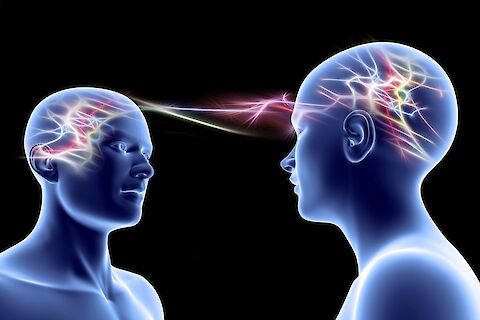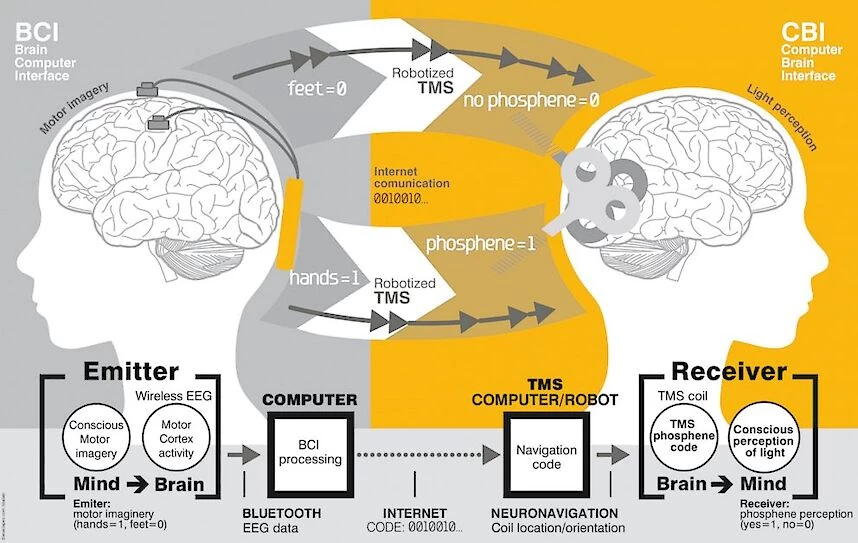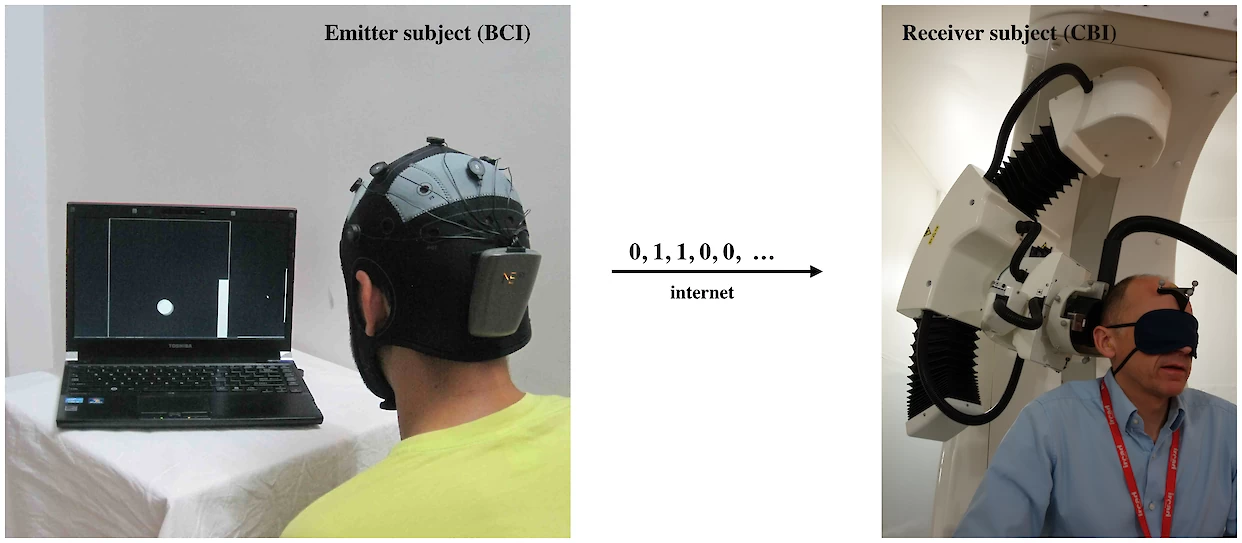

Thought Transference
In the late 1800's, thought transference became quite popular. Not only were people performing what seemed to be such acts on a public stage, people were playing what was called 'The Willing Game' in their homes. Just as people would entertain themselves with Ouija Boards during this era to see if they could communicate with a spirit, they played 'The Willing Game' to see if they could 'will' a person into unknowingly performing an act or finding an object etc by using the power of their mind in what you could say is a form of telepathy or what was described as 'thought transference'.
Some years ago, a parlour pastime called 'Willing Game' was a favourite amusement and gave rise to much public discussion. Certain person were very expert at what appeared to be "thought reading," a few became professional performers. The public were greatly mystified, some considering it a trick, others that the remarkable success attained in private circles proved that trickery was out of the question, and afforded evidence of genuine "thought transference." But the usual method of playing the game showed that a simpler explanation could be given. The blindfolded performer, whom we may call the percipient, had to do something that had been concealed from him, such as to find a hidden object, pick out a certain person, or write a figure on a blackboard, etc. Some on of the company who knew the secret, and whom we will call the agent, laid his hand lightly on the shoulders or forehead of the percipient, sometimes he grasped the hand of the latter and placed it on his forehead, and then thought intently of the thing to be done, but made no conscious effort of guidance. If the percipient were a good subject, and allowed his mind to remain passive. he rarely failed to accomplish what was desired; nor could he give the least explanation of how he did it. Both agent and percipient were equally astonished, and it is no wonder that those who took part in the performance at home were convinced that some kind of mental wireless telegraphy occurred, independently of the senses.
Barrett goes on in his book to talk about some experiments he conducted in 1877 with a friend who was a famous surgeon at the time. The subject who was the person they were experimenting on left the room so he could not see nor hear Barrett and his surgeon friend Mr Lawson Tait. Barrett and Mr Tait decided that the subject should be influenced telepathically to move the fire screen and double it back when he came back into the room. Mr Tait proceeded to put his arms around the waist of the subject and mentally willed the subject to perform this act. At first, the subject seemed like he didn't know what to do until he spontaneously went and did exactly what Mr Tait willed him mentally to do. There were many further instances where Barrett talks about his subjects performing the tasks they were mentally willed to do without any sort of noticeable physical or verbal cue (which had been witnessed with public thought transference performers).
One of the explanations given by physical researchers other than what seemed like genuine acts of telepathy was that the subjects were led by involuntarily muscle movements given by the person 'willing' them to perform an act ...
consciously or unconsciously , the indications involuntarily and unwittingly supplied to him by the muscles of the subject
Think of a similar concept to the ideomotor effect when it comes to Ouija Boards. It is an involuntary muscle movement that can then lead a person to unconsciously move the planchette on the board. Backing up this theory was the fact that when subjects were asked to verbally communicate what it is that they were willed to do, they couldn't seem to answer the question as consciously they really had no idea what they were supposed to do. They could not verbalize it however when they were asked to just go and do what they felt like they had to do, there was a high success rate. It suggested that the information was either received telepathically or the person was guided with muscle movement with both occurring on an unconscious level.
We know that telepathy itself has been tested in a variety of ways over the years. From Zener Cards through to Ganzfeld experiments, parapsychologists attempted to find ways to test telepathy. See my article Experiments in telepathy: https://llifs.com.au/blog/experiments-in-telepathy/
It is only natural that this evolves as does technology.
Scientists Transmit Thoughts from one Brain to Another
In 2014, a team of researchers from Harvard Medical School teaching affiliate Beth Israel Deaconess Medical Center, Starlab Barcelona in Spain, and Axilum Robotics in Strasbourg, France sent messages from one human brain to another from India to France. The distance was 5,000 miles (8046.72km). No chips of physical brain manipulation or surgery was required. They used the internet!

Image Source: https://journals.plos.org/plosone/article?id=10.1371/journal.pone.0105225
On the left, the BCI subsystem is shown schematically, including electrodes over the motor cortex and the EEG amplifier/transmitter wireless box in the cap. Motor imagery of the feet codes the bit value 0, of the hands codes bit value 1. On the right, the CBI system is illustrated, highlighting the role of coil orientation for encoding the two bit values. Communication between the BCI and CBI components is mediated by the internet.
Four participants who were described as 'healthy' individuals aged between 28 - 50 were selected for the program. The emitter or person sending the message was stationed at the BCI Branch (the left brain above). The other 3 subjects known as the receivers were stationed at the CBI branch (the right brain above).

Image Source: https://journals.plos.org/plosone/article?id=10.1371/journal.pone.0105225
On the sender's end, the words "ciao" and "hola" were translated into binary code. This was shown to the emitter (BCI) who was told to create an action for the code such as moving their hand for a 0 and their foot for a 1 etc. An EEG then captured the electrical information that was being read in the sender's brain which created its own sort of neural code. This was then transmitted to the receivers. With their eyes and ears covered, they were shown lights in their peripheral vision. If the light appeared in one spot it was a 1 and in another, it was a 0 and so on.
In these experiments we demonstrated the feasibility of direct brain-to-brain communication in human subjects, with special care taken to ensure the non-participation of sensory or motor systems in the exchange of information (Figure 1). Streams of pseudo-random bits representing the words “hola” and “ciao” were successfully transmitted mind-to-mind between human subjects separated by a great distance, with a negligible probability of this happening by chance.
https://journals.plos.org/plosone/article?id=10.1371/journal.pone.0105225
You can read the official Scientific journal published on this experiment here: https://journals.plos.org/plosone/article?id=10.1371/journal.pone.0105225
Of course, this doesn't exactly prove the concept of telepathy, it more so creates an artificial intelligence version of thought transference. It brings up some interesting questions on a moral, ethical and spiritual level as well. It does make you wonder just what the brain is capable of achieving? It seems it has the capability to send and receive the information, in this experiment's case, it just took the internet to be the carrier of the information so to speak. A lot of true telepathic experiments are often discredited due to the sheer amount of fraud that is often associated with it. As Barrett states in his book, there do seem to be some genuine accounts of telepathy, however, when a person becomes a professional performer, their audience is paying to see the goods. What may have started as genuine became tainted as people constantly had to show that they could perform such acts, through any means possible to save face.
Telepathic experiments have been occurring since the 1800's however we don't seem to hear as much about them in modern-day research. Is it because we have moved on and evolved or because many have given up on trying to test it due to the fraud and control problems? Human deception is probably one of the biggest problems with paranormal research as a whole. Whether it is on a conscious or even an unconscious level, there is always that seed of doubt.
Do you think we can telepathically send and receive information or do you believe we are led by visual and physical cues or involuntary muscle movement? I would also love to hear any stories where you have successfully sent or received some sort of message telepathically! Tell me in the comments below!
If you enjoy this article, there is plenty of content like this in my book Stuff Paranormal Investigators Need To Know Volume 2: My brain is the key that sets you free
References:
https://journals.plos.org/plosone/article?id=10.1371/journal.pone.0105225
If you enjoy LLIFS, consider buying me a book (otherwise known as buy me a coffee but I don't drink coffee and I LOVE books). Your donation helps to fund the LLIFS website so everyone can continue to access great paranormal content and resources for FREE!

Top pages with similar subjects
Don't forget to follow the Facebook page for regular updates
Join the mailing list to receive weekly updates of NEW articles. Never miss an article again!
Buy the latest and past issues Haunted Magazine
Check out the books written by LLIFS